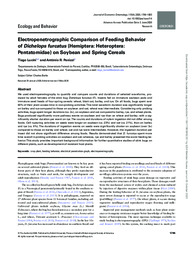Electropenetrographic comparison of feeding behavior of dichelops furcatus (Hemiptera: Heteroptera: Pentatomidae) on soybean and spring cereals .
Electropenetrographic comparison of feeding behavior of dichelops furcatus (Hemiptera: Heteroptera: Pentatomidae) on soybean and spring cereals .
Autoria: LUCINI, T.; PANIZZI, A. R.
Resumo: We used electropenetrography to quantify and compare counts and durations of selected waveforms, produced by adult females of the stink bug Dichelops furcatus (F.). Insects fed on immature soybean pods and immature seed heads of four spring cereals: wheat, black oat, barley, and rye. On all foods, bugs spent over 60% of their plant access time in non-probing activities. This total waveform duration was significantly longer on barley and rye compared to those on soybean and oat; wheat was intermediate. Considering only probing activities, bugs spent longer durations (ca. 2×), on soybean and oat compared to barley, rye, and wheat plants. Bugs produced significantly more pathway events on soybean and rye than on wheat and barley; with a significantly shorter duration per event on rye. The counts and durations of xylem ingestion did not differ among foods. Cell rupturing activities on seeds were longer on soybean (ca. 23%) and oat (ca. 21%), than on barley and rye (ca. 6%). The durations of ingestion events on seeds were significantly shorter on soybean (over 3×) compared to those on barley and wheat; oat and rye were intermediate. However, the ingestion duration per insect did not show significant difference among foods. Results demonstrated that D. furcatus spent more time overall in probing activities on soybean and oat; whereas, rye and barley presented the worst feeding behavior. This study provides important background information for further quantitative studies of stink bugs on different plants, such as development of resistant host plants. Key words: crop plant, feeding behavior, electrical penetration graph, electropenetrography
Ano de publicação: 2020
Tipo de publicação: Artigo de periódico
Unidade: Embrapa Trigo
Palavras-chave: Crop plant, Electrical penetration graph, Electropenetrography, Feeding behavior
Observações
1 - Por padrão são exibidas publicações dos últimos 20 anos. Para encontrar publicações mais antigas, configure o filtro ano de publicação, colocando o ano a partir do qual você deseja encontrar publicações. O filtro está na coluna da esquerda na busca acima.
2 - Para ler algumas publicações da Embrapa (apenas as que estão em formato ePub), é necessário ter, no celular ou computador, um desses softwares gratuitos. Sistemas Android: Google Play Livros; IOS: iBooks; Windows e Linux: software Calibre.
Acesse outras publicações
Acesse a Base de Dados da Pesquisa Agropecuária (BDPA) para consultar o acervo completo das bibliotecas da Embrapa.

